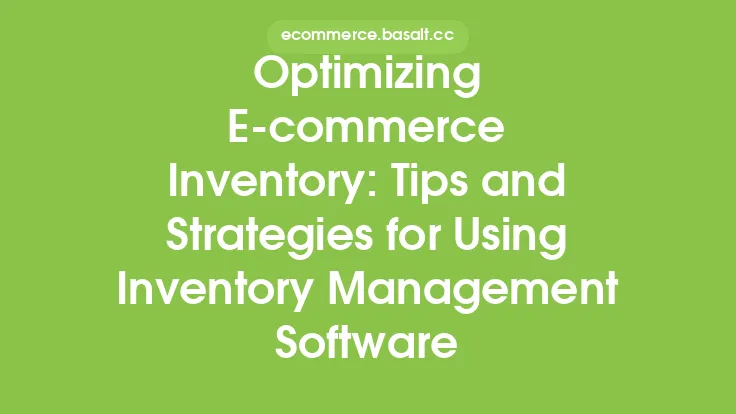In recent years, the e-commerce industry has experienced rapid growth, with more and more consumers turning to online shopping for convenience, flexibility, and accessibility. However, this growth has also raised concerns about the environmental and social impact of e-commerce, highlighting the need for sustainable business models that prioritize social responsibility and minimize harm to the planet. Creating a sustainable e-commerce business model requires careful consideration of various factors, including supply chain management, product sourcing, packaging, shipping, and customer engagement. In this article, we will explore the key tips and strategies for creating a sustainable e-commerce business model that not only benefits the environment and society but also drives long-term success and profitability.
Understanding the Principles of Sustainable E-commerce
Sustainable e-commerce is built on the principles of reducing waste, conserving resources, and promoting social responsibility. It involves adopting practices that minimize the negative impact of e-commerce on the environment, such as reducing energy consumption, using eco-friendly packaging, and sourcing products from sustainable suppliers. Sustainable e-commerce also prioritizes social responsibility, ensuring that business practices are fair, transparent, and respectful of human rights and labor standards. By embracing these principles, e-commerce businesses can reduce their environmental footprint, improve their reputation, and build trust with customers who increasingly expect companies to prioritize sustainability and social responsibility.
Conducting a Sustainability Audit
To create a sustainable e-commerce business model, it is essential to conduct a thorough sustainability audit of your operations. This involves assessing your current practices, identifying areas for improvement, and setting goals for reducing waste, conserving resources, and promoting social responsibility. A sustainability audit should examine various aspects of your business, including supply chain management, product sourcing, packaging, shipping, and customer engagement. It should also consider the environmental and social impact of your operations, such as energy consumption, water usage, and labor practices. By conducting a sustainability audit, you can identify opportunities for improvement, prioritize initiatives, and develop a roadmap for creating a more sustainable e-commerce business model.
Developing a Sustainable Supply Chain
A sustainable supply chain is critical to creating a sustainable e-commerce business model. This involves working with suppliers who share your commitment to sustainability and social responsibility, sourcing products from environmentally friendly and socially responsible sources, and ensuring that labor practices are fair and transparent. When developing a sustainable supply chain, consider factors such as the environmental impact of production, the use of renewable energy, and the treatment of workers. You should also prioritize transparency and accountability, ensuring that suppliers are held to high standards of sustainability and social responsibility. By developing a sustainable supply chain, you can reduce the environmental and social impact of your operations, improve your reputation, and build trust with customers.
Implementing Sustainable Packaging and Shipping Practices
Packaging and shipping are critical components of e-commerce, but they can also have a significant environmental impact. To create a sustainable e-commerce business model, it is essential to implement sustainable packaging and shipping practices. This involves using eco-friendly packaging materials, minimizing packaging waste, and optimizing shipping routes to reduce fuel consumption and lower emissions. Consider using biodegradable or recyclable packaging materials, such as cardboard, paper, or bioplastics, and avoid using single-use plastics or excessive packaging. You should also explore alternative shipping options, such as electric or hybrid vehicles, and consider offsetting carbon emissions from shipping. By implementing sustainable packaging and shipping practices, you can reduce waste, lower emissions, and improve your environmental footprint.
Engaging Customers in Sustainability Efforts
Customer engagement is critical to creating a sustainable e-commerce business model. By educating customers about the importance of sustainability and social responsibility, you can build trust, drive loyalty, and encourage customers to make more sustainable choices. Consider implementing initiatives such as carbon offsetting, product take-back programs, or sustainable product recommendations. You should also provide customers with information about the environmental and social impact of products, such as the use of sustainable materials, fair labor practices, or eco-friendly production methods. By engaging customers in sustainability efforts, you can create a community of like-minded individuals who share your commitment to sustainability and social responsibility, driving long-term success and profitability.
Measuring and Reporting Sustainability Performance
To create a sustainable e-commerce business model, it is essential to measure and report sustainability performance. This involves tracking key performance indicators (KPIs) such as energy consumption, water usage, waste reduction, and social responsibility metrics. Consider using sustainability reporting frameworks, such as the Global Reporting Initiative (GRI) or the Sustainability Accounting Standards Board (SASB), to provide a comprehensive and transparent picture of your sustainability performance. You should also publish regular sustainability reports, providing stakeholders with information about your progress, challenges, and opportunities for improvement. By measuring and reporting sustainability performance, you can identify areas for improvement, prioritize initiatives, and demonstrate your commitment to sustainability and social responsibility.
Creating a Culture of Sustainability
Creating a sustainable e-commerce business model requires a culture of sustainability that permeates every aspect of your organization. This involves educating employees about the importance of sustainability and social responsibility, providing training and resources to support sustainable practices, and encouraging employees to suggest initiatives and ideas for improving sustainability performance. Consider establishing a sustainability team or task force to drive sustainability efforts, provide guidance and support, and ensure that sustainability is integrated into every aspect of your business. By creating a culture of sustainability, you can drive long-term success and profitability, improve your reputation, and build trust with customers who expect companies to prioritize sustainability and social responsibility.





